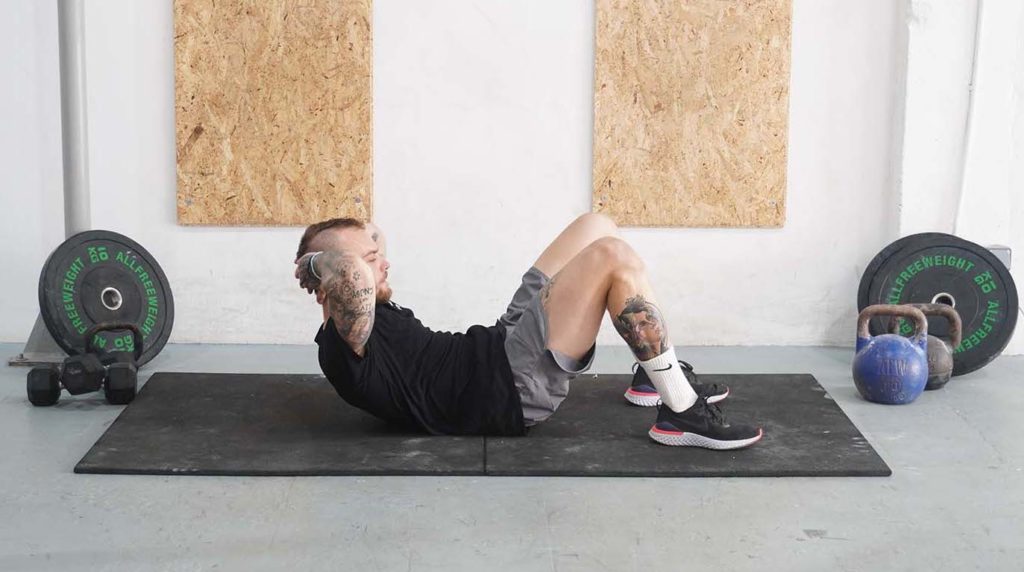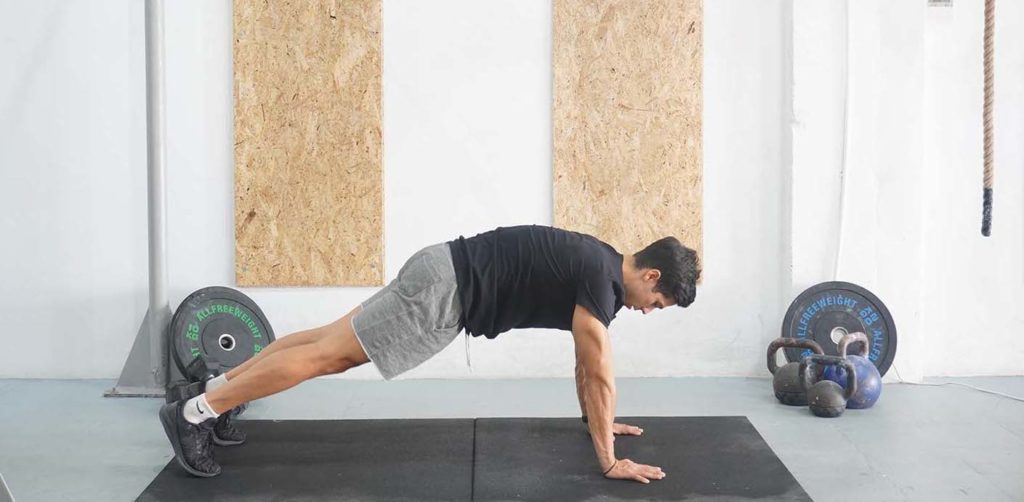Build Core Strength with the V Up
V up crunches are a challenging bodyweight exercise that builds strength, stability, and athleticism. The objective is to lie on the floor, extend your body, and raise your torso and legs simultaneously. Doing so recruits a range of muscles in your body and forces you to work extra hard and remain stable.
The V up crunch is particularly effective for strengthening the rectus abdominis because the muscle has to produce a lot of force to crunch your torso and help you lift your legs in the air. Performing the exercise strengthens your core, improves your stability, protects your spine, and improves posture.
We recommend including V ups near the end of your workouts after doing the main lifts: squats, deadlifts, bench press, overhead press, and similar. If you want to do the movement as part of an ab routine, we recommend doing V ups first or second while you’re still fresh.
How to do a V Up
- Lie on the floor with your legs straight, feet together, and arms extended behind your head. Your heels, thighs, butt, upper back, shoulders, head, and forearms should be in contact with the floor.
- Take a deep breath, engage your abs, and initiate the movement by simultaneously raising your torso and legs toward one another.
- As you raise your torso and legs, keep your arms in line with your upper body.
- Near the end of the repetition, allow your arms to lean toward your legs slightly and tap your shins with your fingers.
- As you exhale, slowly unfold yourself back to the starting position.
- Take another breath and repeat.
What muscles does the V Up activate?
The primary muscle that works during V ups is the rectus abdominis, which spans from just below the ribcage to the pelvic bone. Its primary function is to bring the chest closer to the hips by crunching the torso (1). The rectus abdominis also provides torso stability and assists the hip flexors in raising our legs during exercises like V ups.
Other midsection muscles (including the obliques and transverse abdominis) also work during V ups, primarily to keep us stable while doing the exercise (1). Similarly, the back musculature contributes to torso rigidity.
The glutes, hamstrings, and quadriceps work during V ups to stabilize our legs and lift them off the floor. Our shoulders (deltoids) and upper back muscles move the arms behind the body and to the ceiling.
How to Work up to Doing a V Up
V ups might seem easy enough at first glance, but the exercise requires a fair amount of strength and stability to perform effectively.
The primary muscle that works during V ups is the rectus abdominis, and strengthening it will improve your performance. Fantastic ab exercises include regular/decline/cable crunches, planks, hanging knee raises, and lying leg raises. Doing crunches and leg raises separately is an excellent way to break down the V up exercise and learn the two motions in isolation.

Compound exercises like front squats, standing military press, and deadlifts are also beneficial for strengthening your midsection, making the V up more accessible.
Once you’ve built up enough strength in your midsection, you can introduce hollow holds to the mix. The objective is to lie on the floor, raise your upper back and legs off the floor, and maintain the position for a period. Doing so builds isometric strength and stability, making it easier to progress to V ups.
Once you’ve built enough strength, you can start doing V ups slowly, focusing on smooth execution and a full range of motion. We’ll discuss what mistakes you should avoid below.
Variations and Modifications of the V Up
1. Bent-Knee V Up
The bent-knee V up is an easier variation that brings many benefits. Unlike regular V ups, the objective is to keep your knees bent as you raise your legs and torso. Doing so requires less core strength and stability, making the exercise more beginner-friendly.
2. Alternating Leg V Up
The alternating leg V up is a variation where you lift one leg at a time. For example, you raise your torso and lift the left leg to the ceiling. You then return to the starting position, crunch again, and lift the right leg.
3. V Up Hold
The V up hold is another beginner-friendly exercise that builds isometric strength and whole-body stability. Assume the starting position, brace your core, and raise your torso and legs to the ceiling. Once at the top position, hold for 5 to 30 seconds and release.
Mistakes to Avoid
A common mistake with V ups is performing repetitions too quickly, leading to instability, robbing your muscles of tension, and making the exercise less effective. The objective is to do repetitions smoothly and with good control to feel your muscles work. Doing fewer but slower repetitions is much better than rushing through the exercise, hoping to reach an arbitrary rep goal.
Another mistake with V ups is rocking back and forth. Doing so isn’t dangerous, but it makes the exercise less effective and prevents you from training your abs as best as possible. Avoid the mistake by doing repetitions slowly and controlling your body from start to finish.
The third error with V ups is relaxing your muscles on the way down. Many trainees would perform the first half of a V up correctly but relax their muscles and ‘unfold’ back to the starting position. Doing so prevents them from taking full advantage of each repetition’s eccentric (negative) portion, making the movement less effective. Avoid the mistake by keeping your muscles tense throughout each repetition.
Similar Exercises to the V Up
Decline Crunch
Decline crunches are a simple and effective isolation exercise for the rectus abdominis. The objective is to anchor your feet inside a decline bench and perform crunches. Like V ups, decline crunches emphasize your abs and promote torso stability.
Cable Crunch
Cable crunches are an effective isolation movement for the abs. But, unlike most exercises, cable crunches offer more flexibility because you can adjust the load based on your strength. You can start with as little as 10 to 20 lbs and gradually increase the resistance as your abs develop and strengthen.
Plank

Planks are a versatile isometric exercise that promotes whole-body stability and strength. Similar to V ups, the plank targets the abs, back, shoulders, chest, arms, glutes, hamstrings, and more (2). All of these muscles flex isometrically to keep us stable and in position.

